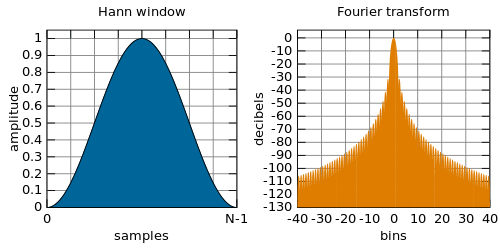Hann function

The Hann function, named after the Austrian meteorologist Julius von Hann, is a discrete window function given by
or
or, in terms of the haversine function,
Spectrum
The Hann window is a linear combination of modulated rectangular windows . From Euler's formula
Due to the basic properties of the Fourier transform, its spectrum is
with the spectrum of the rectangular window
(the modulation factor vanishes if windows are time-shifted around 0).
Name
Hann function is the original name, in honour of von Hann; however, the erroneous "Hanning" function is also heard of on occasion, derived from the paper in which it was named, where the term "hanning a signal" was used to mean applying the Hann window to it. The confusion arose from the similar Hamming function, named after Richard Hamming.
Use
The Hann function is typically used as a window function in digital signal processing to select a subset of a series of samples in order to perform a Fourier transform or other calculations.
i.e. (using continuous version to illustrate)
Such windows are also widely called "Hanning windows" and "Hann'd".
The advantage of the Hann window is very low aliasing, and the tradeoff is slightly decreased resolution (widening of the main lobe). If the Hann window is used to sample a signal in order to convert to frequency domain, it is complex to reconvert to the time domain without adding distortions.
See also
References
- Harris, F. J. (1978). "On the use of windows for harmonic analysis with the discrete Fourier transform". Proceedings of the IEEE. 66: 51. doi:10.1109/PROC.1978.10837.
- Blackman, R. B.; Tukey, J. W. (1958). "The Measurement of Power Spectra from the Point of View of Communications Engineering - Part I". Bell System Technical Journal. 37: 185. doi:10.1002/j.1538-7305.1958.tb03874.x.